
Atracidae is a family of mygalomorph spiders, commonly known as Australian funnel-web spiders or atracids. It has been included as a subfamily of the Hexathelidae, but is now recognised as a separate family. All members of the family are native to Australia. Atracidae consists of three genera: Atrax, Hadronyche, and Illawarra, comprising 35 species. Some members of the family produce venom that is dangerous to humans, and bites by spiders of six of the species have caused severe injuries to victims. The bites of the Sydney funnel-web spider and northern tree-dwelling funnel-web spider are potentially deadly, but no fatalities have occurred since the introduction of modern first-aid techniques and antivenom.

Funnel-web spider refers to many different species of spider, particularly those that spin a web in the shape of a funnel:

The Araneomorphae are an infraorder of spiders. They are distinguishable by chelicerae (fangs) that point diagonally forward and cross in a pinching action, in contrast to the Mygalomorphae, where they point straight down. Araneomorphs comprise the vast majority of living spiders.

Octavius Pickard-Cambridge FRS was an English clergyman and zoologist. He was a keen arachnologist who described and named more than 900 species of spider.
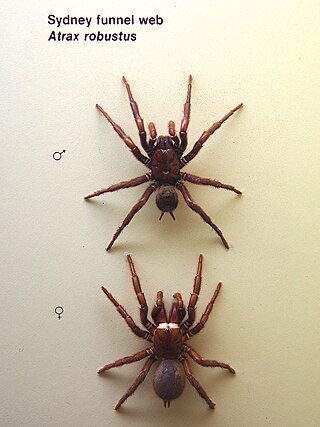
The Sydney funnel-web spider is a species of venomous mygalomorph spider native to eastern Australia, usually found within a 100 km (62 mi) radius of Sydney. It is a member of a group of spiders known as Australian funnel-web spiders. Its bite is capable of causing serious illness or death in humans if left untreated.

Araneus is a genus of common orb-weaving spiders. It includes about 650 species, among which are the European garden spider and the barn spider. The genus was erected by Carl Alexander Clerck in 1757.

Eresus, also called ladybird spiders, is a genus of velvet spiders that was first described by Charles Athanase Walckenaer in 1805. Members of the genus formerly called Eresus cinnaberinus or Eresus niger are now placed in one of three species: Eresus kollari, Eresus sandaliatus and Eresus moravicus.

Atrax is a genus of venomous Australian funnel web spiders that was first described by O. Pickard-Cambridge in 1877 from the type species Atrax robustus. As of May 2019 it contains only three species: A. robustus, A. sutherlandi, and A. yorkmainorum. Originally placed with the curtain web spiders, it was moved to the Hexathelidae in 1980, then to the Australian funnel-web spiders in 2018.
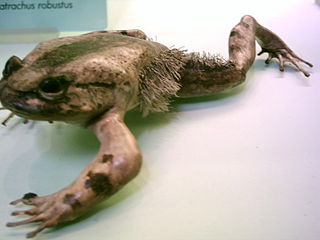
The hairy frog also known as the horror frog or Wolverine frog, is a Central African species of frog in the family Arthroleptidae. It is typically considered monotypic within the genus Trichobatrachus, but based on genetic it should be included in Astylosternus instead. Its common name refers to the somewhat hair-like structures on the body and thighs of the breeding male.
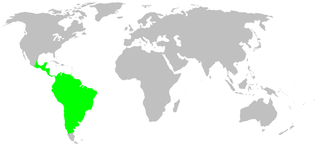
Senoculus is a genus of araneomorph spiders in the family Senoculidae, and was first described by Władysław Taczanowski in 1872. It is the only genus in the family Senoculidae.

Ero aphana is a species of pirate spider in the family Mimetidae. It is a hunting spider and feeds on other spiders.

Barnby Broad and Marshes is a Site of Special Scientific Interest (SSSI) in the Waveney district of the English county of Suffolk. The site is 189.6 hectares in size. It is in the parishes of North Cove and Barnby, located between Beccles and Lowestoft in the north of the county. The site is bordered on its southern edge by the East Suffolk railway line and to the north by the River Waveney. It is a Special Area of Conservation, a Special Protection Area under the EC Birds Directive, and a Ramsar internationally important wetland site. There are two Suffolk Wildlife Trust nature reserves in the site, Castle Marshes and North Cove.

Parley Common is a Site of Special Scientific Interest (SSSI) on the edge of Ferndown in Dorset, England. The majority land owner is the Canford Estate, but among the other owners are the Diocese of Salisbury, Dorset County Council, East Dorset District Council and a few private individuals. Most of the site is managed by the Amphibian and Reptile Conservation Trust (ARC); East Dorset Countryside Management Service manage the area owned by East Dorset District Council and Dorset Countryside manage the area owned by Dorset County Council. The site was notified as an SSSI in 1983.

Hadronyche cerberea, the southern tree-dwelling funnel-web spider, is a venomous mygalomorph spider found in central New South Wales, Australia.
Gnaphosa lugubris is a ground spider species found from Europe to Central Asia.
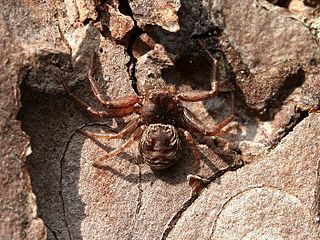
Coriarachne is a genus of crab spiders that was first described by Tamerlan Thorell in 1870. Over half of described species have been synonymized or moved to similar genera, including Bassaniana, Bassaniodes, and Pycnaxis.
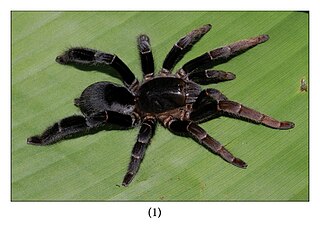
Lyrognathus is a genus of Asian tarantulas that was first described by Reginald Innes Pocock in 1895.
Brachionopus is a genus of South African tarantulas that was first described by Reginald Innes Pocock in 1897. It was transferred to the Theraphosidae from the Barychelidae in 1985.

Bassaniodes is a genus of crab spiders that was first described by Reginald Innes Pocock in 1903.

Brachionopus robustus, also known by its common name robust lesser baboon spider, is a species from the genus Brachionopus. The species was originally described by Reginald Innes Pocock in 1897.


















